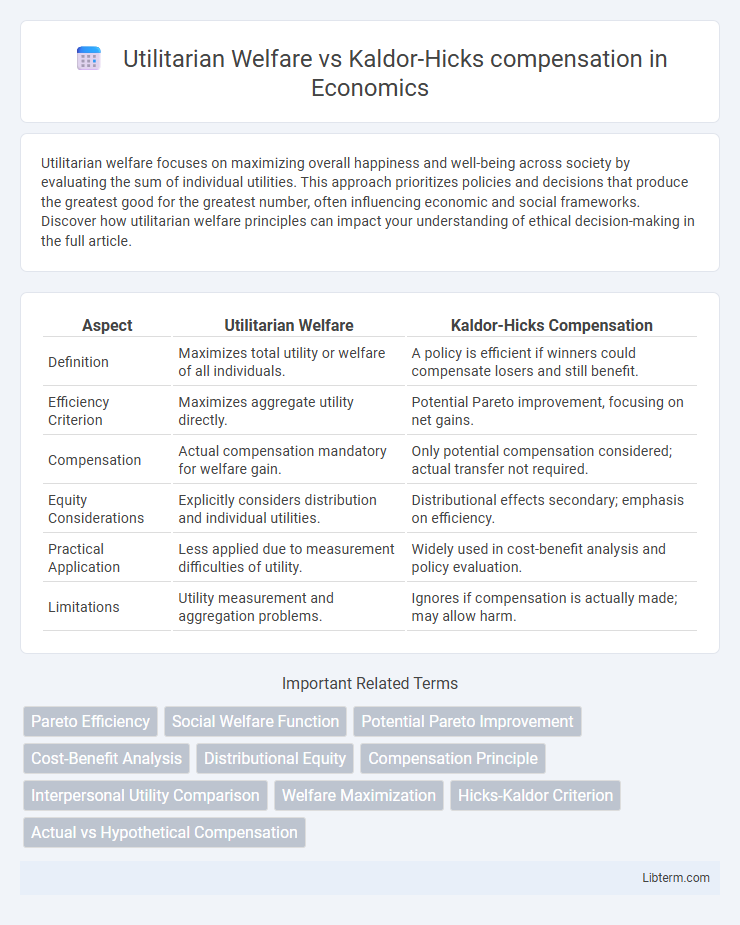Utilitarian welfare focuses on maximizing overall happiness and well-being across society by evaluating the sum of individual utilities. This approach prioritizes policies and decisions that produce the greatest good for the greatest number, often influencing economic and social frameworks. Discover how utilitarian welfare principles can impact your understanding of ethical decision-making in the full article.
Table of Comparison
| Aspect | Utilitarian Welfare | Kaldor-Hicks Compensation |
|---|---|---|
| Definition | Maximizes total utility or welfare of all individuals. | A policy is efficient if winners could compensate losers and still benefit. |
| Efficiency Criterion | Maximizes aggregate utility directly. | Potential Pareto improvement, focusing on net gains. |
| Compensation | Actual compensation mandatory for welfare gain. | Only potential compensation considered; actual transfer not required. |
| Equity Considerations | Explicitly considers distribution and individual utilities. | Distributional effects secondary; emphasis on efficiency. |
| Practical Application | Less applied due to measurement difficulties of utility. | Widely used in cost-benefit analysis and policy evaluation. |
| Limitations | Utility measurement and aggregation problems. | Ignores if compensation is actually made; may allow harm. |
Introduction to Welfare Economics
Utilitarian welfare theory evaluates social welfare based on the aggregation of individual utilities, aiming to maximize total happiness or satisfaction across society. Kaldor-Hicks compensation criterion assesses efficiency by determining whether winners could hypothetically compensate losers, allowing a proposed change to increase overall welfare without requiring actual compensation. Welfare economics explores these concepts to analyze resource allocation and policy impacts, balancing efficiency with equity considerations.
Defining Utilitarian Welfare
Utilitarian welfare is defined by the aggregation of individual utilities into a single social welfare function, aiming to maximize overall happiness or satisfaction across a population. This approach evaluates policy outcomes by summing net benefits, prioritizing the greatest good for the greatest number, regardless of how benefits and losses are distributed. Utilitarian welfare differs from Kaldor-Hicks compensation by not requiring actual compensation to losers but focusing on potential improvements in total social welfare.
Understanding Kaldor-Hicks Compensation
Kaldor-Hicks compensation principle evaluates economic efficiency by comparing potential winners and losers from a policy change, allowing an outcome to be considered efficient if winners could theoretically compensate losers, even without actual compensation occurring. Unlike Utilitarian welfare that aggregates total utility, Kaldor-Hicks focuses on potential Pareto improvements, emphasizing net benefits and feasibility in real-world policy decisions. Understanding this compensation criterion is essential for assessing projects where redistribution is possible but not enforced, highlighting practical implications in cost-benefit analysis and welfare economics.
Core Principles: Utility vs. Compensation
Utilitarian welfare centers on maximizing total utility, aggregating individual well-being to achieve the greatest overall happiness. Kaldor-Hicks compensation assesses changes based on whether those who gain could theoretically compensate those who lose, ensuring Pareto improvements without requiring actual compensation. These core principles distinguish utility-focused welfare economics from compensation-based efficiency criteria.
Measuring Social Welfare: Utilitarian Approach
The Utilitarian approach to measuring social welfare evaluates overall utility by summing individual utilities, aiming to maximize total happiness across society. Unlike Kaldor-Hicks compensation, which assesses potential Pareto improvements without requiring actual compensation, Utilitarianism prioritizes the aggregate welfare outcome regardless of distributional equity. This approach underpins policy analysis by quantifying social welfare changes based on individual utility functions and their social aggregator.
Efficiency and Distribution: Kaldor-Hicks Perspective
Kaldor-Hicks compensation emphasizes efficiency by allowing economic changes where winners could theoretically compensate losers, even if no actual compensation occurs, facilitating potential Pareto improvements. This approach prioritizes overall net gains in wealth or utility without requiring equitable distribution among all parties involved. While utilitarian welfare focuses on maximizing total utility with explicit regard to distributional effects, Kaldor-Hicks concentrates on aggregate efficiency, often overlooking actual income redistribution or fairness in outcomes.
Real-World Examples and Applications
Utilitarian welfare principles prioritize maximizing overall happiness or utility, commonly applied in cost-benefit analyses for public policy decisions like healthcare resource allocation and infrastructure projects. Kaldor-Hicks compensation, used in environmental economics and urban development, assesses economic efficiency by allowing policy changes if winners could theoretically compensate losers, seen in cases like emission trading schemes and eminent domain disputes. Real-world applications highlight utilitarianism's focus on aggregate welfare versus Kaldor-Hicks' practical approach to compensation feasibility without guaranteeing actual redistribution.
Criticisms and Limitations
Utilitarian welfare often faces criticism for overlooking individual rights and distributional fairness, as it aggregates total utility without accounting for disparities among individuals. Kaldor-Hicks compensation is limited by its reliance on hypothetical compensation, which may never be actualized, leading to potential ethical and practical issues. Both frameworks struggle with measuring utility accurately and fail to address externalities, making them less effective for comprehensive policy evaluation.
Policy Implications: Choosing a Framework
Selecting between Utilitarian Welfare and Kaldor-Hicks compensation frameworks significantly shapes policy evaluation by emphasizing aggregate social welfare versus potential Pareto improvements. Utilitarian approaches prioritize maximizing total utility, guiding policies that benefit society at large even if some individuals incur losses. Kaldor-Hicks compensation allows policies where winners could theoretically compensate losers, enabling consideration of efficiency gains without requiring actual compensation, which influences the feasibility and equity assessment of economic reforms.
Conclusion: Comparing Welfare Criteria
Utilitarian welfare maximizes total social utility by summing individual utilities, emphasizing overall well-being without requiring compensation for losers. Kaldor-Hicks compensation focuses on potential Pareto improvements, allowing policies where winners could compensate losers, even if compensation doesn't actually occur. Comparing these criteria highlights a trade-off between strict fairness and practical efficiency in policy evaluation frameworks.
Utilitarian Welfare Infographic

 libterm.com
libterm.com